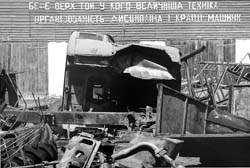Are politics behind gasoline price hikes?

The fuel price hikes that started in the second half of August have hit the pockets of taxpayers and affected company performance. The week before last the price of A-76 gasoline more than doubled, with prices of A-92 and A-95 up by over 22%. Diesel fuel went up in price by 22-25%. Word has it that the government might resort to administrative controls to hold down prices in the capital. Kyiv Mayor Oleksandr Omelchenko spoke of a certain pattern, with fuel prices increasing in the fall for the third time in the past four years. In his view, this is due to the harvest and sowing season. Simultaneously, Vasyl Yastrubynsky, chief of the Kyiv City Administration Department for Pricing Policy, believes there is no reason whatever for such major price hikes in Kyiv. According to him, “it is unreasonable to blame this on higher oil and fuel prices on the global market and in Russia, because prices in Kyiv are increasing at a rate exceeding growth rates elsewhere many times over.” He further pointed to “an aggressive upward trend” of fuel prices quoted by wholesale traders, with the wholesale price of A-76 gasoline and diesel fuel exceeding retail prices at filling stations. Simultaneously, Mr. Yastrubynsky believes there are objective economic reasons for price increases within a 5-15% margin, but “not at the rate set by wholesale traders.”
A similar trend is discernible in some other regions. Oleksiy Antonov, expert with the Spivdruzhnist [commonwealth] Concern, who monitors the situation in Kherson and other southern oblasts, told The Day that fuel prices at filling stations are lower than those at wholesale petroleum depots. According to him, wholesale prices have increased by 25- 30%. In his view, this is due to the fact that oil refineries’ stocks are depleted, and “oil refineries are marking up prices in view of the deficit.” According to Mr. Antonov, such an oil processing giant as the Kremenchuk Oil Refinery — which, incidentally, receives oil from Tatarstan — currently has some 3,500 tons of oil, while twice as much is needed for normal operation of the refinery.
Dnipropetrovsk oblast has also seen fuel price surges. Oblast State Administration Chairman Volodymyr Yatsuba is in a bellicose mood and even promises to “force” fuel traders to set fair prices.
According to Antimonopoly Committee Chairman Oleksiy Kostusiev, in September the committee will complete an investigation into an alleged price fixing deal between two major fuel traders in Dnipropetrovsk oblast, Aviac Ltd. and Sentoza Oil, each accounting for 30% of the regional market.
Simultaneously, the Antimonopoly Committee is monitoring the situation in the country. Thus far, there has been no threat of a major crisis. However, as The Day learned from Petro Ambrozevych, chief of the Antimonopoly Committee First Research Department, higher prices have been caused mostly by external factors combined with both seasonal price fluctuations in Ukraine and fluctuations on the global oil market. In August alone, global oil prices were up $28 per ton. According to Mr. Ambrozevych, Russia as the major importer of oil into Ukraine wants to cash in on this situation. Under such conditions, even Russian oil refineries run short of crude, since most of it is exported. And if formerly fuel prices in Russia were substantially lower (in the dollar equivalent) than in Ukraine, now they are more or less equal. Nonetheless, he believes Ukraine will have enough fuel to prevent a deficit and panic buying, as was the case in 1999. According to Mr. Ambrozevych, suspicions that oil refineries could be holding back fuel to cause price hikes have not been confirmed. On the contrary, stock levels are even lower than they were in the previous months. However, the Antimonopoly Committee has warned the government that should local administrations overreact and attempt to restrict prices through administrative controls, this could disrupt market processes and destabilize the fuel market. Committee experts think that administrative controls in Ukraine could cause a fuel drain to Europe.
Independent experts believe the country is on the verge of an energy crisis. Such is the belief of Serhiy Sapehin, director of Psykheya [Psyche] scientific and technical center and editor-in-chief of the Terminal oil review. According to him, the Kremenchuk Oil Refinery is practically idle, with petroleum product reserves below 60,000 tons against the usual 100,000-120,000 tons. The Kherson Oil Refinery has been shut down for planned upgrading of the production facilities.
Meanwhile, the Odesa and Lysychansk Oil Refineries supply oil exclusively to their own network of filling stations. The Shebelynka Gas Processing Plant resumed gas shipments only in late August. To quote Mr. Sapehin, the true cause of limited oil import from Russia is Ukrainian government’s reluctance to back-pump oil via the Odesa-Brody pipeline and the delay with the creation of the gas transport consortium.
Put simply, Ukraine is being pressured. This has happened before. “It reminds me of the year 2000 when the issue of gas debts and so-called gas pilferage was addressed in like manner,” said Mr. Sapehin. “Then we faced a similar situation with petroleum products imported into Ukraine from Russia.”
Meanwhile, Fuel and Energy Minister Serhiy Yermilov, whom Russian TNK oil company, owner of Ukraine’s major oil refinery LINOS, accused in its letter to Pres. Kuchma of resisting back-pumping of oil via the Odesa- Brody pipeline, seems to have found a way out. The minister officially charged his first deputy cum Naftohaz Ukrayiny chairman Yury Boiko, notorious for his support of back-pumping, with responsibility for the price situation on the fuel market. How this situation will be resolved is anyone’s guess. However, it does not take an expert to understand that it is a side effect of the privatization of Ukrainian oil refineries exclusively by Russian oil companies. It is also obvious that the lobby of the Russian companies in Ukraine is not restricted to their supporters among the leadership of the Ukrainian fuel and energy sector.






